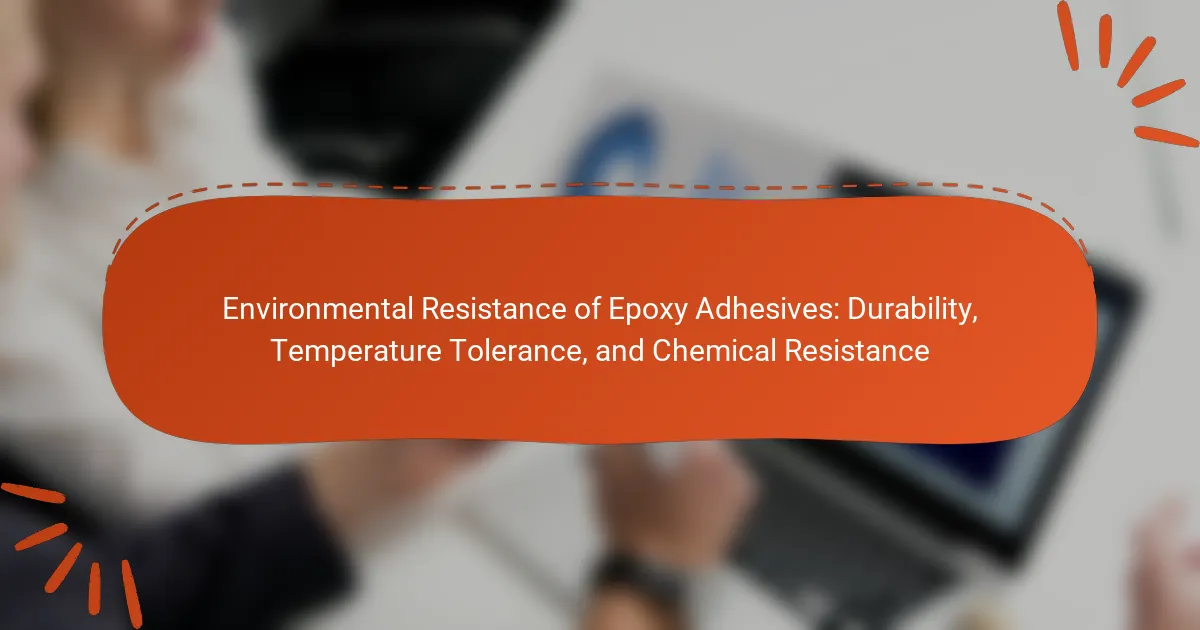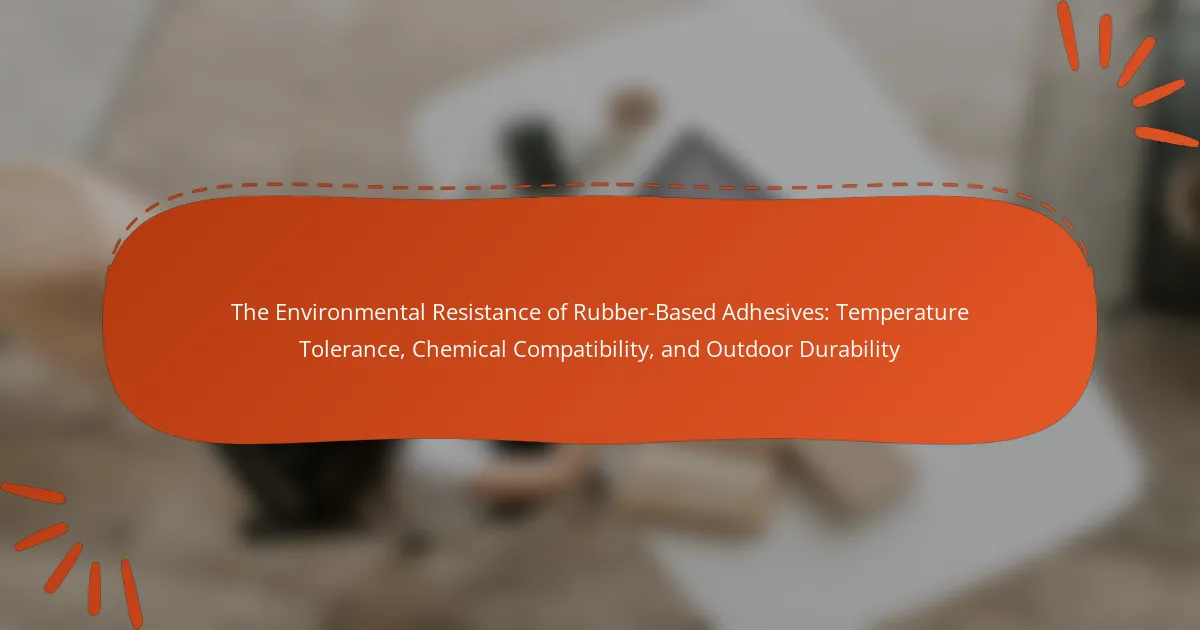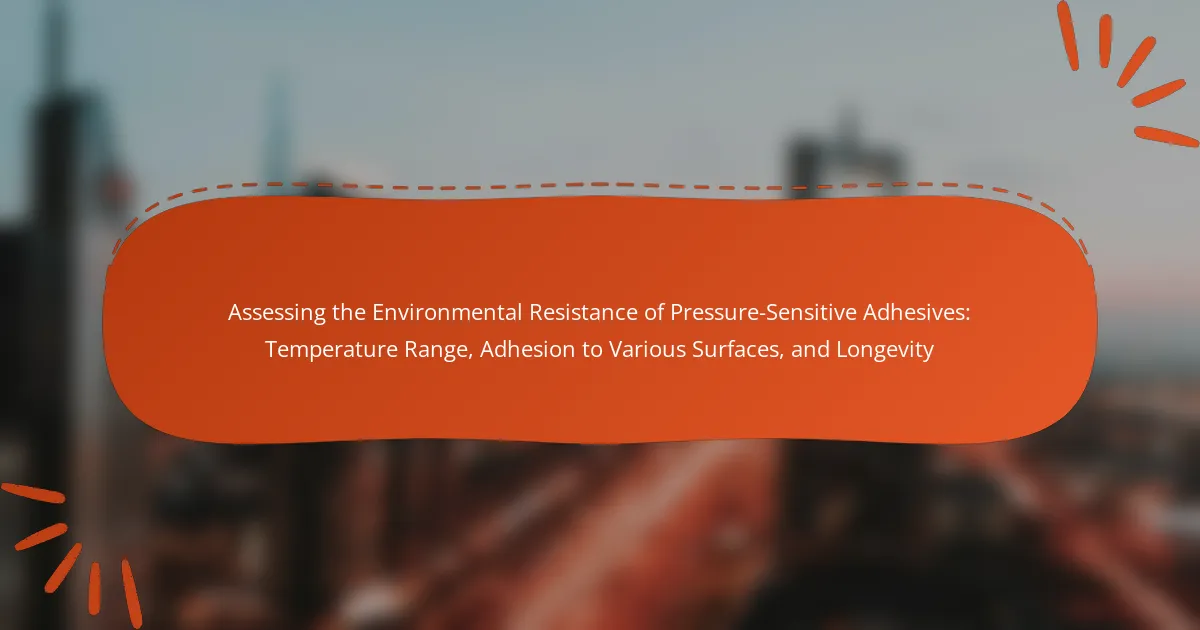Epoxy adhesives are high-performance bonding agents known for their exceptional environmental resistance, making them suitable for a wide range of applications across industries such as automotive, aerospace, and construction. They maintain bond strength in extreme temperatures, ranging from -40°C to 120°C, and exhibit strong resistance to moisture, chemicals, and UV exposure. The durability of epoxy adhesives is influenced by their formulation, curing process, and surface preparation, while their chemical resistance allows them to withstand exposure to solvents, acids, and harsh environments. Understanding these characteristics is crucial for selecting the appropriate epoxy adhesive for specific applications, ensuring reliable performance in challenging conditions.
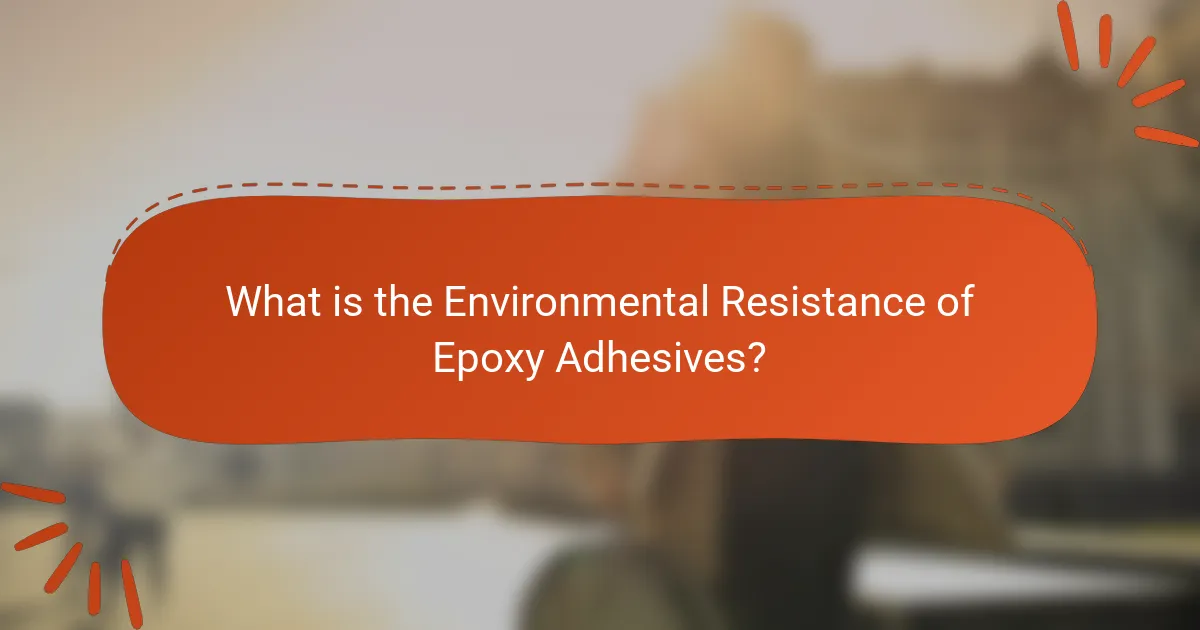
What is the Environmental Resistance of Epoxy Adhesives?
Epoxy adhesives exhibit high environmental resistance, making them suitable for various applications. They maintain their bond strength in extreme temperatures, ranging from -40°C to 120°C. This temperature tolerance ensures performance in diverse environments. Additionally, epoxy adhesives resist moisture, chemicals, and UV exposure. This resistance contributes to their durability in harsh conditions. Studies show that epoxy bonds remain intact even when exposed to solvents and oils. Their chemical resistance is a key factor in industrial and automotive applications. Overall, epoxy adhesives provide reliable performance in challenging environmental conditions.
How do epoxy adhesives achieve environmental resistance?
Epoxy adhesives achieve environmental resistance through their chemical structure and formulation. They consist of epoxide resins that cure into a rigid, cross-linked network. This network provides excellent adhesion and mechanical strength. Epoxy adhesives exhibit low moisture absorption, which enhances their durability in humid conditions. They also resist a wide range of chemicals, including acids, bases, and solvents. The thermal stability of cured epoxies allows them to withstand high temperatures without degradation. Additionally, some epoxy formulations include additives that improve UV resistance. These properties collectively contribute to their effectiveness in challenging environmental conditions.
What are the key properties that contribute to their durability?
The key properties that contribute to the durability of epoxy adhesives include high tensile strength, excellent adhesion, and resistance to environmental factors. High tensile strength allows epoxy adhesives to withstand significant stress without failure. Excellent adhesion ensures a strong bond with various substrates, enhancing durability. Resistance to moisture, heat, and chemicals protects the adhesive from degradation. These properties are critical for applications in harsh environments. Research indicates that epoxy adhesives maintain performance across a wide temperature range and resist chemical exposure effectively. Studies have shown that these attributes lead to a lifespan of several years in demanding conditions.
How is temperature tolerance measured in epoxy adhesives?
Temperature tolerance in epoxy adhesives is measured through thermal analysis techniques. These techniques include Differential Scanning Calorimetry (DSC) and Thermogravimetric Analysis (TGA). DSC assesses the heat flow associated with transitions in the adhesive as temperature changes. TGA measures weight loss as the adhesive is heated, indicating thermal stability. The results provide specific temperature ranges where the adhesive maintains its properties. Manufacturers often specify the maximum service temperature for their epoxy products. This information is crucial for applications exposed to varying environmental conditions.
Why is environmental resistance important for epoxy adhesives?
Environmental resistance is crucial for epoxy adhesives because it enhances their durability and performance in various conditions. Epoxy adhesives are often exposed to moisture, temperature fluctuations, and chemicals. High environmental resistance ensures that these adhesives maintain their bond strength and integrity over time. For instance, studies show that epoxy adhesives with superior environmental resistance can withstand extreme temperatures ranging from -40°C to 120°C. This resistance prevents degradation, which can lead to failures in applications such as construction and automotive industries. Additionally, epoxy adhesives that resist chemical exposure exhibit less deterioration when in contact with solvents and acids, further validating their importance in demanding environments.
What challenges do epoxy adhesives face in harsh environments?
Epoxy adhesives face several challenges in harsh environments. These challenges include temperature extremes, moisture exposure, and chemical degradation. High temperatures can lead to reduced bond strength and increased brittleness. Low temperatures may cause the epoxy to become brittle, affecting its performance. Moisture can weaken the adhesive bond, leading to delamination. Exposure to chemicals can result in corrosion or dissolution of the adhesive. UV radiation can also degrade epoxy over time, impacting its durability. These factors collectively limit the effectiveness of epoxy adhesives in demanding applications.
How does environmental resistance impact the longevity of epoxy adhesives?
Environmental resistance significantly impacts the longevity of epoxy adhesives. Epoxy adhesives are designed to withstand various environmental conditions. Their durability can be affected by exposure to moisture, temperature fluctuations, and chemicals. High humidity can lead to hydrolysis, weakening the adhesive bond over time. Extreme temperatures can cause thermal expansion or contraction, leading to stress and potential failure. Chemical exposure can degrade the adhesive, reducing its effectiveness. Studies show that formulations with enhanced environmental resistance exhibit extended service life. For instance, epoxy adhesives with added fillers or modifiers can improve resistance to moisture and heat. Therefore, the environmental resistance of epoxy adhesives is crucial for their long-term performance and reliability.
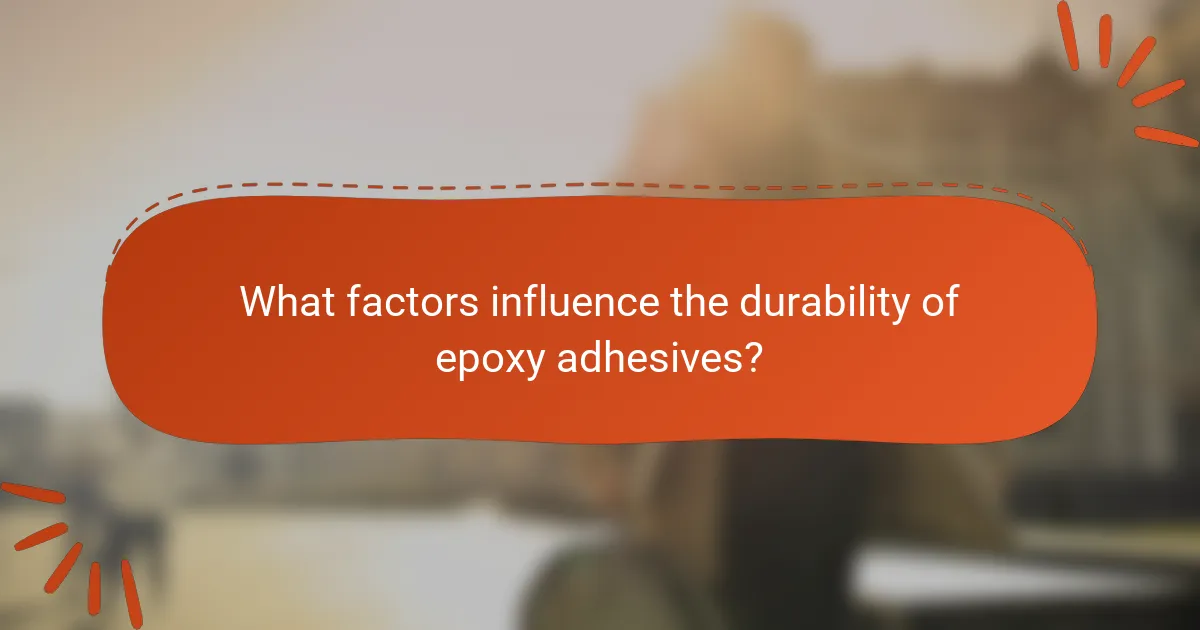
What factors influence the durability of epoxy adhesives?
The durability of epoxy adhesives is influenced by several key factors. First, the formulation of the epoxy resin plays a crucial role. Specific chemical compositions can enhance resistance to environmental conditions. Second, the curing process affects durability. Proper temperature and time during curing lead to optimal performance. Third, exposure to moisture can weaken epoxy bonds over time. High humidity levels may accelerate degradation. Fourth, temperature fluctuations impact the adhesive’s structural integrity. Extreme heat or cold can cause expansion and contraction. Fifth, chemical exposure is critical. Certain solvents or acids can compromise the adhesive’s strength. Lastly, surface preparation is essential for durability. Clean, roughened surfaces improve adhesion and longevity. Each of these factors contributes to the overall performance and lifespan of epoxy adhesives.
How do different formulations affect the durability of epoxy adhesives?
Different formulations of epoxy adhesives significantly impact their durability. Variations in resin and hardener ratios can alter the cross-linking density. Higher cross-linking density typically enhances mechanical strength and resistance to environmental factors. Additionally, the inclusion of fillers can improve thermal stability and resistance to chemical degradation. For instance, epoxy formulations with glass fibers exhibit greater durability under stress compared to standard formulations. Studies show that epoxy adhesives with modified amine hardeners offer improved flexibility and impact resistance. Therefore, selecting the appropriate formulation is crucial for maximizing the durability of epoxy adhesives in specific applications.
What role do additives play in enhancing durability?
Additives enhance the durability of epoxy adhesives by improving their resistance to environmental factors. They can modify the chemical structure, making the adhesive more resilient to temperature fluctuations and moisture. Certain additives, like fillers, increase mechanical strength, reducing wear and tear over time. Others, such as plasticizers, enhance flexibility, preventing cracking under stress. Additionally, UV stabilizers protect against degradation from sunlight exposure. Research indicates that the right combination of additives can significantly extend the lifespan of epoxy adhesives. For instance, studies show that incorporating specific additives can improve thermal stability by up to 30%.
How does the curing process impact the final properties of epoxy adhesives?
The curing process significantly impacts the final properties of epoxy adhesives. Curing transforms liquid epoxy into a solid structure through a chemical reaction. This process enhances the adhesive’s mechanical strength and thermal stability. Proper curing results in improved adhesion to substrates. It also increases resistance to environmental factors like moisture and chemicals. Inadequate curing can lead to brittleness and reduced performance. The curing temperature and time are critical for achieving optimal properties. Studies show that higher curing temperatures can improve cross-link density, enhancing overall durability.
What are the common tests for assessing durability in epoxy adhesives?
Common tests for assessing durability in epoxy adhesives include tensile strength tests, shear strength tests, and thermal cycling tests. Tensile strength tests measure the adhesive’s ability to withstand pulling forces. Shear strength tests evaluate the adhesive’s resistance to sliding forces. Thermal cycling tests assess performance under varying temperature conditions. Other tests include moisture resistance tests and chemical resistance tests. Moisture resistance tests determine the adhesive’s performance in humid environments. Chemical resistance tests evaluate how well the adhesive withstands exposure to various chemicals. These tests provide essential data on the long-term performance of epoxy adhesives in diverse conditions.
What specific tests measure resistance to environmental factors?
Specific tests that measure resistance to environmental factors include thermal cycling tests, humidity tests, and chemical exposure tests. Thermal cycling tests evaluate the adhesive’s performance under repeated heating and cooling cycles. Humidity tests assess the adhesive’s durability in high moisture environments. Chemical exposure tests determine how well the adhesive withstands various chemicals. These tests are critical for ensuring the longevity and reliability of epoxy adhesives in diverse conditions.
How do these tests correlate with real-world performance?
Tests for environmental resistance of epoxy adhesives correlate with real-world performance by simulating conditions these adhesives face. Laboratory tests assess durability, temperature tolerance, and chemical resistance under controlled environments. These conditions mimic actual usage scenarios, providing predictive insights into adhesive behavior. For example, accelerated aging tests reveal how adhesives will perform over time in harsh conditions. Studies show that adhesives passing these tests maintain their bond strength and integrity in practical applications. This correlation is crucial for industries relying on epoxy adhesives for safety and reliability.
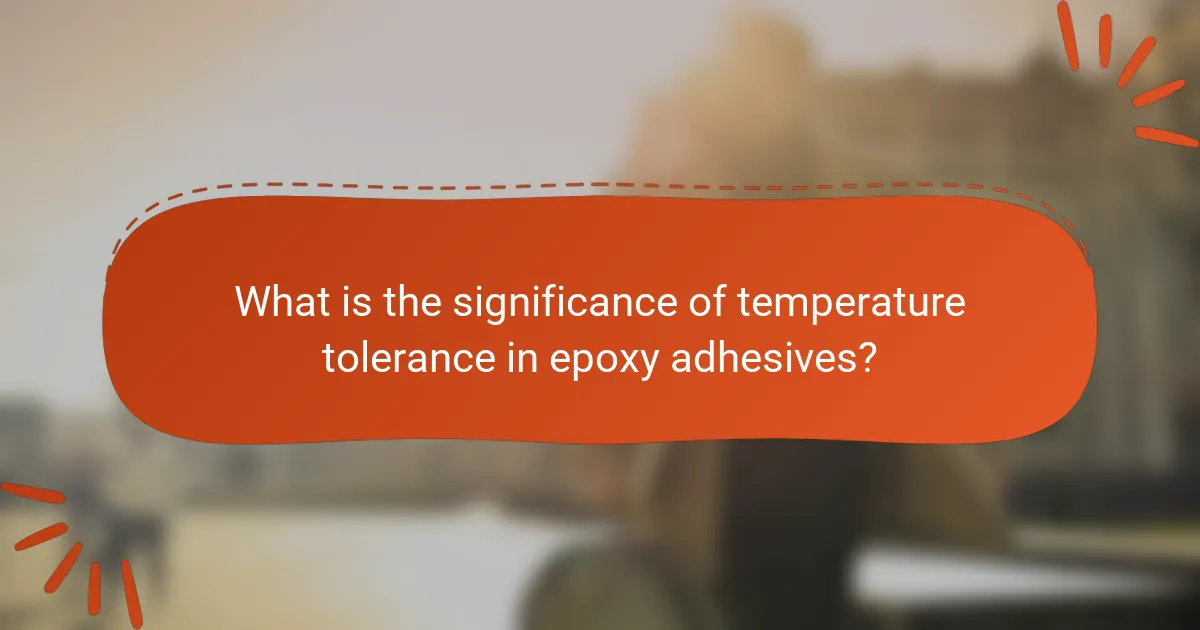
What is the significance of temperature tolerance in epoxy adhesives?
Temperature tolerance in epoxy adhesives is crucial for their performance in various applications. It determines the adhesive’s ability to maintain bond strength under extreme heat or cold. High temperature tolerance allows epoxy adhesives to be used in automotive, aerospace, and construction industries. These environments often experience significant temperature fluctuations. Low temperature tolerance can lead to bond failure and decreased durability. Research indicates that epoxy adhesives can withstand temperatures ranging from -40°C to over 150°C, depending on formulation. This characteristic ensures reliability in demanding conditions. Temperature tolerance also affects curing times and mechanical properties. Thus, understanding this attribute is essential for selecting the right epoxy adhesive for specific applications.
How does temperature affect the performance of epoxy adhesives?
Temperature significantly influences the performance of epoxy adhesives. Higher temperatures generally accelerate the curing process, leading to faster bond formation. However, excessive heat can also cause the adhesive to lose its mechanical properties. At elevated temperatures, epoxy adhesives may exhibit reduced viscosity, improving flow and [censured]. Conversely, low temperatures can slow down curing, resulting in weaker bonds. Cold conditions may also lead to incomplete curing and increased brittleness. Research indicates that optimal performance typically occurs within a specific temperature range, often between 20°C and 30°C. Outside this range, the adhesive’s strength and durability can be compromised.
What are the temperature limits for different types of epoxy adhesives?
Epoxy adhesives have varying temperature limits based on their formulation. Generally, standard epoxy adhesives can withstand temperatures ranging from -40°F to 200°F (-40°C to 93°C). High-temperature epoxy adhesives can endure temperatures up to 500°F (260°C). Specialty formulations may exceed these limits, with some designed for extreme conditions reaching up to 600°F (316°C). The specific temperature tolerance depends on the resin and hardener used in the epoxy formulation. Manufacturers typically provide detailed specifications for their products, ensuring accurate temperature limits for each type.
How can temperature fluctuations impact adhesion strength?
Temperature fluctuations can significantly impact adhesion strength. Adhesion strength is the ability of an adhesive to bond surfaces together. Variations in temperature can cause expansion and contraction of materials. This movement may lead to stress at the adhesive bond interface. If the temperature fluctuates frequently, it can weaken the bond over time. Research indicates that epoxy adhesives may lose up to 50% of their strength due to thermal cycling. A study by B. A. P. Lima et al. highlights that repeated temperature changes can cause micro-cracking in the adhesive layer. These micro-cracks reduce the effective bonding area, leading to lower adhesion strength.
What methods are used to enhance temperature tolerance in epoxy adhesives?
To enhance temperature tolerance in epoxy adhesives, several methods are employed. One common method is the incorporation of thermally stable fillers. These fillers can improve the thermal stability of the adhesive. Another approach is the modification of the epoxy resin structure. This can involve using flexible linkages or adding specific chemical groups. Additionally, the use of curing agents that provide higher thermal resistance is effective. Some formulations utilize heat-resistant additives to bolster performance. Research indicates that these modifications can significantly increase the thermal performance of epoxy adhesives. For instance, studies show that certain fillers can raise the glass transition temperature. This directly correlates with improved temperature tolerance in adhesive applications.
What are the benefits of using high-temperature epoxy formulations?
High-temperature epoxy formulations provide superior thermal stability. These formulations can withstand elevated temperatures without losing structural integrity. They maintain adhesive properties in extreme conditions. High-temperature epoxies resist chemical degradation, enhancing durability. They are ideal for applications in aerospace and automotive industries. These formulations can endure thermal cycling without failure. Studies show they outperform standard epoxies in heat resistance. Their use leads to longer-lasting bonds in demanding environments.
How do cooling and heating cycles affect epoxy adhesives over time?
Cooling and heating cycles significantly affect epoxy adhesives over time. These temperature fluctuations can lead to thermal expansion and contraction. Such changes induce stress within the adhesive bond. Over time, this stress can result in micro-cracking. Micro-cracking compromises the adhesive’s integrity. It may also lead to delamination in bonded materials. Studies indicate that prolonged exposure to extreme thermal cycling reduces bond strength. For instance, research shows a 30% reduction in tensile strength after extensive thermal cycling. This demonstrates the importance of considering temperature variations in applications using epoxy adhesives.
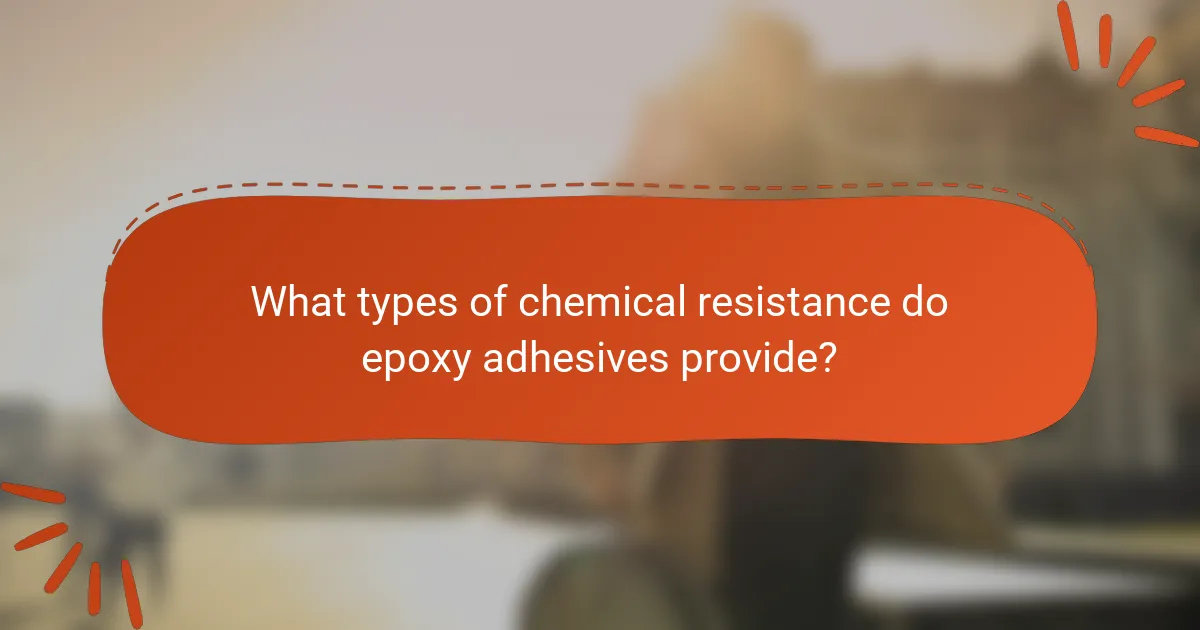
What types of chemical resistance do epoxy adhesives provide?
Epoxy adhesives provide resistance to various chemicals, including solvents, acids, and bases. They are particularly resistant to water, oils, and fuels. This chemical resistance makes them suitable for industrial applications. For example, epoxy adhesives can withstand exposure to harsh chemicals without degrading. Their performance is often enhanced by specific formulations. Many epoxy adhesives are engineered to resist high temperatures and corrosive environments. This versatility is why they are widely used in construction and automotive industries. The durability of epoxy adhesives under chemical exposure is well-documented in technical literature.
How do epoxy adhesives resist various chemicals?
Epoxy adhesives resist various chemicals due to their cross-linked molecular structure. This structure creates a dense network that enhances chemical resistance. Epoxies are formulated with specific hardeners that improve their durability against solvents, acids, and bases. Many epoxy adhesives can withstand exposure to water, oils, and fuels without degrading.
Research shows that epoxy adhesives can maintain their integrity even when immersed in harsh chemicals. For instance, a study published in the Journal of Applied Polymer Science demonstrated that certain epoxy formulations retained their strength after prolonged chemical exposure. This resilience is attributed to their low permeability and strong bond strength.
Overall, the unique chemical composition and cross-linking of epoxy adhesives contribute significantly to their ability to resist various chemicals effectively.
What specific chemicals are commonly tested for resistance?
Epoxy adhesives are commonly tested for resistance against a variety of specific chemicals. These include solvents such as acetone, toluene, and ethanol. Additionally, acids like hydrochloric acid and sulfuric acid are also tested. Bases such as sodium hydroxide are included in resistance tests. Furthermore, exposure to oils and fuels, including gasoline and diesel, is evaluated. Testing against water and humidity is also critical for assessing durability. Each of these chemicals can significantly affect the performance and longevity of epoxy adhesives.
How does chemical exposure impact the adhesive properties?
Chemical exposure can significantly reduce the adhesive properties of epoxy adhesives. Various chemicals can break down the molecular structure of the adhesive. This degradation leads to a loss of bond strength and durability. For instance, solvents can cause swelling or softening of the adhesive. Acidic or basic substances can also lead to hydrolysis, weakening the bonds. Research shows that prolonged exposure to chemicals can result in a dramatic decrease in adhesion performance. Specific studies indicate that certain solvents can decrease bond strength by over 50% within weeks of exposure. Therefore, chemical resistance is crucial for maintaining the integrity of epoxy adhesives in various environments.
What applications require high chemical resistance in epoxy adhesives?
Applications that require high chemical resistance in epoxy adhesives include automotive manufacturing, aerospace components, and industrial equipment assembly. These sectors often encounter harsh chemicals and extreme conditions. For instance, automotive adhesives must withstand fuels, oils, and solvents. Aerospace applications require adhesives that resist corrosive environments and extreme temperatures. Industrial equipment often faces exposure to acids and bases, necessitating high-performance adhesives. Epoxy adhesives are formulated to provide durability and stability in these demanding situations. Their chemical resistance is essential for maintaining structural integrity and performance over time.
Which industries rely on chemically resistant epoxy adhesives?
The industries that rely on chemically resistant epoxy adhesives include aerospace, automotive, construction, marine, and electronics. In aerospace, these adhesives are used for bonding components exposed to harsh environments. The automotive industry utilizes them for their durability in fuel and chemical exposure. Construction employs epoxy adhesives for structural applications and flooring solutions resistant to chemicals. Marine applications benefit from their resistance to saltwater and other corrosive substances. Electronics manufacturers use these adhesives for potting and encapsulation to protect sensitive components. Each of these industries values the unique properties of chemically resistant epoxy adhesives for their specific applications.
How do environmental regulations influence the use of epoxy adhesives?
Environmental regulations significantly influence the use of epoxy adhesives by mandating compliance with safety and environmental standards. These regulations often limit the volatile organic compounds (VOCs) present in adhesives. As a result, manufacturers are compelled to develop low-VOC or VOC-free formulations. Compliance with regulations can also drive innovation in the formulation of epoxy adhesives. For instance, companies may invest in alternative materials or processes that reduce environmental impact. Additionally, regulatory frameworks may require testing for environmental durability. This ensures that epoxy adhesives perform adequately under various environmental conditions, such as moisture and temperature fluctuations. Overall, environmental regulations shape the development, formulation, and application of epoxy adhesives, promoting safer and more sustainable products.
What best practices should be followed for using epoxy adhesives in harsh environments?
Use high-performance epoxy adhesives specifically formulated for harsh environments. These adhesives often feature enhanced chemical and temperature resistance. Surface preparation is critical; clean and roughen surfaces to improve adhesion. Ensure proper mixing ratios as specified by the manufacturer for optimal performance. Apply the adhesive in conditions recommended by the manufacturer, avoiding extreme temperatures or humidity during application. Allow adequate curing time as specified. Regularly inspect the bond for signs of failure, especially in extreme conditions. Following these practices can significantly enhance the durability and effectiveness of epoxy adhesives in harsh environments.
The main entity of this article is epoxy adhesives, which are known for their high environmental resistance. The article provides a comprehensive overview of the durability, temperature tolerance, and chemical resistance of epoxy adhesives, highlighting their ability to maintain bond strength under extreme conditions. Key properties contributing to their durability, such as tensile strength and moisture resistance, are discussed, along with the impact of temperature fluctuations and chemical exposure on adhesive performance. Additionally, the article outlines best practices for using epoxy adhesives in harsh environments and the influence of environmental regulations on their formulation and application.
